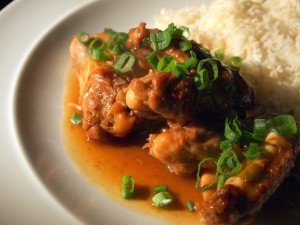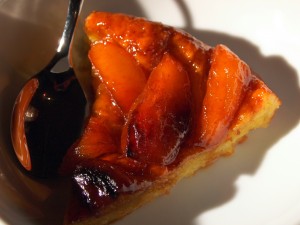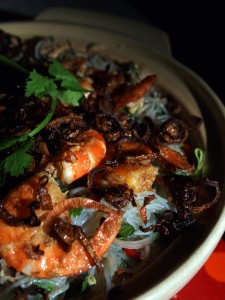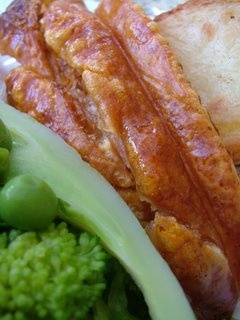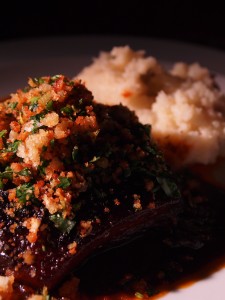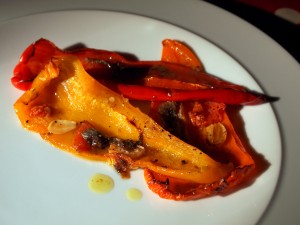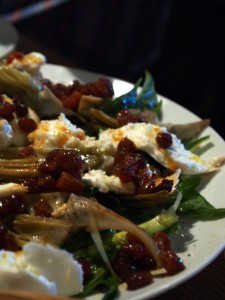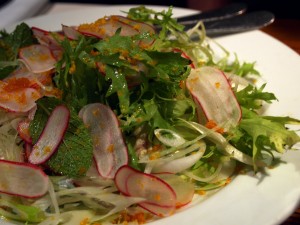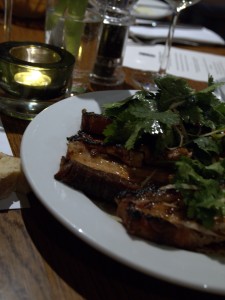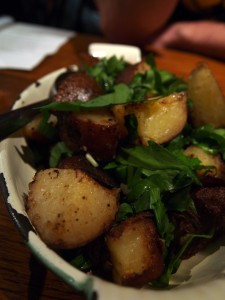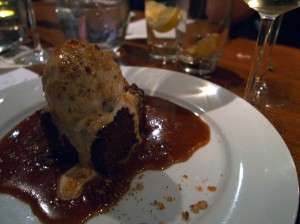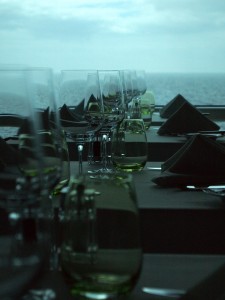
My excuse for being aboard Celebrity Eclipse (see previous post) was the launch of Qsine, a new speciality restaurant. Each of the Solstice class ships has a clutch of four speciality restaurants at the stern end of the fifth deck. Murano, the flagship (sorry) restaurant which I covered last year, appears on each of the ships built so far, alongside Blu and the Tuscan Grille. Qsine takes up the space filled on the previous ships by Silk Harvest, a pan-Asian joint.
Chef Jacques van Staden, whose minute attention to detail is reflected in the décor, plates and even the staff uniforms in each restaurant, was at the head of the table to talk me through this very curious menu. Billed as “uniquely unordinary”, Qsine’s philosophy is all about food as play. Now, this approach isn’t really unique – I’m reminded of some of David Burke’s more frivolous moments, and Sam DeMarco’s frankly mental (and surprisingly successful) reinterpretations of American favourites. (You haven’t lived until you’ve eaten DeMarco’s Philly cheesesteak dumplings). But I like JVS’s take on it, not least because he seems so serious about making sure his diners spend a meal being anything but serious.
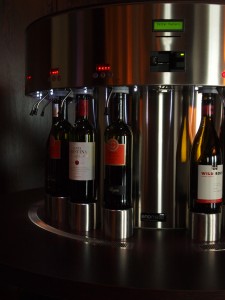
Qsine’s menu warns you something’s not quite normal here. It’s presented on an iPad, to start with, from which you will be able to order directly; and there’s no structured starter/salad/main business, just a solid block of text describing each dish. The dessert menu arrives on a cross between a Rubik’s cube and a Jacob’s ladder. It’ll take you a bit longer to work your way through than a standard menu because of the undifferentiated block of text you’re faced with, but the staff (“culinary tour guides”, insists Chef JVS), are here to advise you on the size of each of these sharing plates, and on which dishes will work well together. You’ll need their advice, because some of the dishes will serve two as an entire meal; others are much smaller. The staff know their onions, though, and will guide you through the menu.
Van Staden is determined you will have fun. There are no molecular techniques in use here, but there’s plenty of very curious presentation. Apparently, 75% of the tableware was commissioned especially for the restaurant and custom-built. I’d been running around the ship all morning taking photographs, and I was hungry. And I was a bit nonplussed to be greeted by a tray of strawberries which had been dipped and decorated to look like mushrooms.
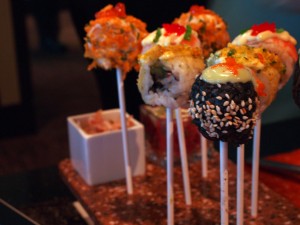
If I’m to be completely honest, my first thought on seeing what arrived on the table was that this feels just like the sort of restaurant a very imaginative and slightly malevolent nine-year-old might have come up with. There are cupcakes in a little tiffin box, with three piping bags full of different frostings to squizzle all over the tops, and a dish of toppings to sprinkle over, including pop rocks (which gave the lady next to me a horrible shock – she’d not encountered them before). Disco shrimp is a shrimp cocktail in a cone of glass that comes set on a bed of ice – but it’s ice packed with flashing blue led lights. There are sliders – tiny Kobe burgers on brioche – but these come disassembled so that you can fill yours with exactly what you fancy. Baby back spring rolls come to the table served in a nest of – you guessed it – springs. There are sushi lollipops, served on sticks and rolled in seasoning. Mine was rolled in benign black sesame, but I’ve spent the last few days wondering how the one that was rolled in crushed Doritos could possibly have tasted. There’s fish and chips for the English audience too – but it’s presented as little fried “popcorn” nuggets, and you can choose between malt vinegar and aioli to anoint them before you get down to eating.
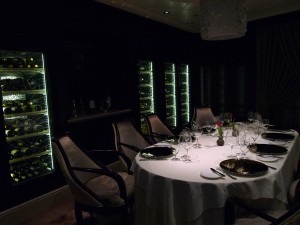
So, clearly, Qsine isn’t offering up haute cuisine. But unexpectedly, the experience turned out to be extraordinarily good fun – I was prepared to scoff at the idea, but I haven’t giggled over dinner so much in a good long time. Outside the over-processed trilogy of meatballs (three fist-sized meatballs in different sauces), which I can’t see staying on the menu for much longer in their present form, everything we ate was well-prepared, and everybody at my large table ended up looking a lot more cheerful than they had when they came in, hungover after the previous night’s celebrations.
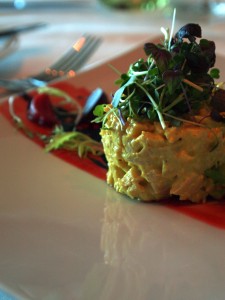
There are plenty of places to eat on the ship, and you’ll inevitably find that some suit you better than others. I enjoyed Blu, which is set up with a spa-type menu (there are also some stodgier dishes for non-spa-visiting partners) – macadamia-crusted scallops and lump crab risotto were particular standouts. And if you’re not a fan of buffet breakfasts, it’s worth heading down to the 5th floor cafe, where breakfast crepes are available for a small surcharge, alongside some good strong coffee. You can pick from the menu, invent a crepe from a list of breakfast ingredients, or, as I found to my very great pleasure, ask for fillings that don’t even appear on the menu – if you just want lemon and sugar, or fancy a particular kind of fruit, the staff will be happy to find some for you.

The logistics of providing food on a cruise ship were something I covered last year when I wrote about Murano, and they still create certain finicky problems that you might not even notice if you’re not a force-12 foodie. Every steak I encountered, flash-frozen and then defrosted very slowly under controlled circumstances, was curiously soft – and legislation that forbids the use of naked flames on board means that they have to be cooked on an electric grill. (I am not sure I enjoy living in a world where we can’t grill our steaks over a flame, but we can have seagoing glass-blowing studios.) In the gargantuan Moonlight Sonata restaurant, which seats hundreds, it’s hard for the staff to accurately control the cuisson of dishes, simply because so many are coming out at once – a long-winded way of saying “don’t have the fish”, at least if you find fish difficult when it’s overcooked. (That said, we had a few very good courses in the Moonlight Sonata restaurant, including an excellent celeriac soup, a seasonal salad with a fierce blue cheese and candied pecans, and a terrific little cone of dense chocolate mousse with lemon curd.)
There’s plenty of food on the ship that I didn’t get a chance to sample – there simply wasn’t time. If you find yourself travelling on Eclipse or either of her sister ships, and have a comment or tip about dining, please leave a comment – I’d love to hear from you!





